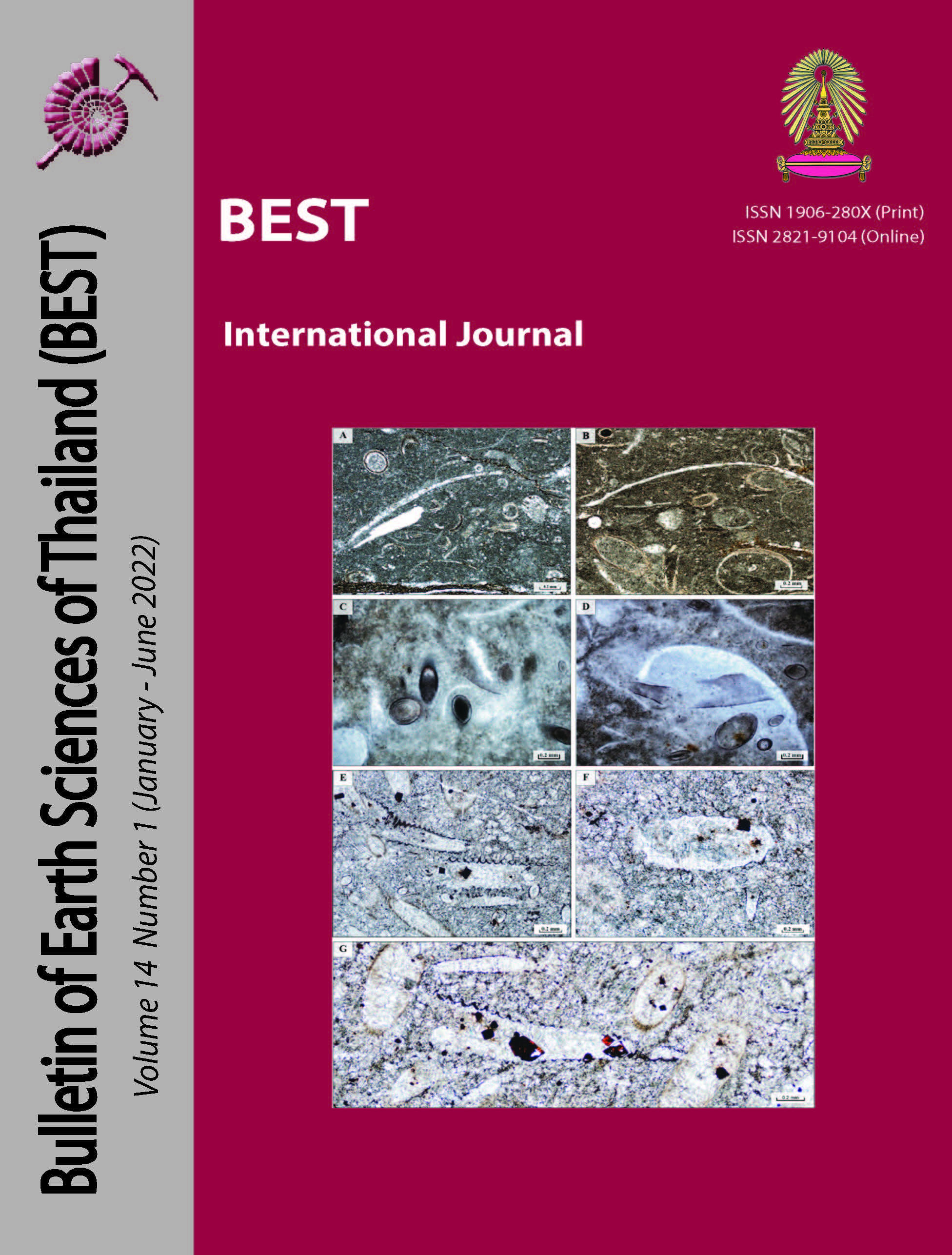Human Impact on Geomorphic Index Alteration at the Chi River in Kosum Phisai, Maha Sarakham, North-eastern Thailand
Main Article Content
Abstract
This paper investigates the impact of human interventions on geomorphic index alteration, especially the effect of sand mining on the floodplain of the Chi river (8.5 Km long) at Kosum Phisai district, Maha Sarakham province, north-eastern Thailand. Four geomorphic indexes, including sinuosity index, channel width, widening rate, and migration rate, were measured and analyzed in five different periods: A.D. 1952, A.D. 1992, A.D. 2006, A.D. 2015 and A.D. 2020. As a result, the widening rate of sand mining area dramatically increased from -0.15 m/year in period A.D.1992 to 2006 (before sand mining) to 16.98 m/year in period A.D. 2006 to 2015 (after sand mining operated). Migration rate also changed from 0.37 m/year in period A.D. 1992 to 2006 to – 9.05 m/year (mid channel migrated to right bank) in period A.D. 2006 to 2015. Both alterations confirm direct human intervention to the river. Our analysis also suggests that river bank protection only reduced the widening rate.
Article Details

This work is licensed under a Creative Commons Attribution-NonCommercial-NoDerivatives 4.0 International License.
Copyright © 2008 Department of Geology, Faculty of Science, Chulalongkorn University. Parts of an article can be photocopied or reproduced without prior written permission from the author(s), but due acknowledgments should be stated or cited accordingly.
References
Biedenharn, D. S., Thorne, C. R., and Watson, C. C. 2000. Recent morphological evolution of the Lower Mississippi River. Geomorphology 34(3-4): 227-249.
Bierman, P., and Montgomery, D. 2014. Hillslope. Key Concepts in Geomorphology: 145-178.
Chen, D., and Liu, M. One-and two-dimensional modeling of deep gravel mining in the Rio Salado. pp. 1-9.
Collins, B., and Dunne, T. 1990. Fluvial geomorphology and river-gravel mining: a guide for planners, case studies included. California Department of Conservation, Division of Mines and Geology.
Duţu, L. T., Provansal, M., Le Coz, J., and Duţu, F. 2014. Contrasted sediment processes and morphological adjustments in three successive cutoff meanders of the Danube delta. Geomorphology 204: 154-164.
Fuller, I. C., Large, A. R., and Milan, D. J. 2003. Quantifying channel development and sediment transfer following chute cutoff in a wandering gravel-bed river. Geomorphology 54(3-4): 307-323.
Gurnell, A., Downward, S., and Jones, R. 1994. Channel planform change on the River Dee meanders, 1876–1992. Regulated rivers: research management 9(4): 187-204.
Hooke, J. 1995. River channel adjustment to meander cutoffs on the River Bollin and River Dane, northwest England. Geomorphology 14(3): 235-253.
Hooke, J. M. 2007. Complexity, self-organisation and variation in behaviour in meandering rivers. Geomorphology 91(3): 236-258.
Kuntiyawichai, K., Schultz, B., Uhlenbrook, S., and Suryadi, F. Delineation of flood hazards and risk mapping in the Chi River Basin, Thailand. pp. 298-313.
Lagasse, P., Zevenbergen, L., Spitz, W., and Thorne, C. R. 2004. Methodology for predicting channel migration.
Lai, X., Yin, D., Finlayson, B. L., Wei, T., Li, M., Yuan, W., Yang, S., Dai, Z., Gao, S., and Chen, Z. 2017. Will river erosion below the Three Gorges Dam stop in the middle Yangtze? Journal of Hydrology 554: 24-31.
Langbein, W. B., and Leopold, L. B. 1964. Quasi-equilibrium states in channel morphology. American Journal of Science 262(6): 782-794.
Leopold, L. B., and Wolman, M. G. 1957. River channel patterns: Braided, meandering, and straight. Professional Paper. Washington, D.C.: U. S. G. P. Office. [in English]
Li, D., Lu, X. X., Chen, L., and Wasson, R. 2019. Downstream geomorphic impact of the Three Gorges Dam: With special reference to the channel bars in the Middle Yangtze River. Earth Surface Processes Landforms 44(13): 2660-2670.
Li, L., Lu, X. X., and Chen, Z. 2007. River channel change during the last 50 years in the middle Yangtze River, the Jianli reach. Geomorphology 85: 185-196.
Makaske, B., Maathuis, B. H., Padovani, C. R., Stolker, C., Mosselman, E., and Jongman, R. H. 2012. Upstream and downstream controls of recent avulsions on the Taquari megafan, Pantanal, south‐western Brazil. Earth Surface Processes Landforms 37(12): 1313-1326.
Mueller, J. E. 1968. An introduction to the hydraulic and topographic sinuosity indexes. Annals of the association of american geographers 58(2): 371-385.
Petts, G. E., and Gurnell, A. M. 2005. Dams and geomorphology: research progress and future directions. Geomorphology 71(1-2): 27-47.
Phillips, J. D. 2009. Changes, perturbations, and responses in geomorphic systems. Progress in Physical Geography: Earth and Environment 33(1): 17-30.
Rinaldi, M., Wyżga, B., and Surian, N. 2005. Sediment mining in alluvial channels: physical effects and management perspectives. River research applications 21(7): 805-828.
Sear, D., and Archer, D. 1998. The effects of gravel extraction on the stability of gravel-bed rivers: A case study from the Wooler Water, Northumberland, UK. Gravel bed rivers in the environment 415: 432.
Williams, G. P., and Wolman, M. G. 1984. Downstream effects of dams on alluvial rivers. US Government Printing Office.
Zawiejska, J., Wyżga, B., and Radecki-Pawlik, A. 2015. Variation in surface bed material along a mountain river modified by gravel extraction and channelization, the Czarny Dunajec, Polish Carpathians. Geomorphology 231: 353-366.
Zhou, M., Xia, J., Lu, J., Deng, S., and Lin, F. 2017. Morphological adjustments in a meandering reach of the middle Yangtze River caused by severe human activities. Geomorphology 285: 325-332.


